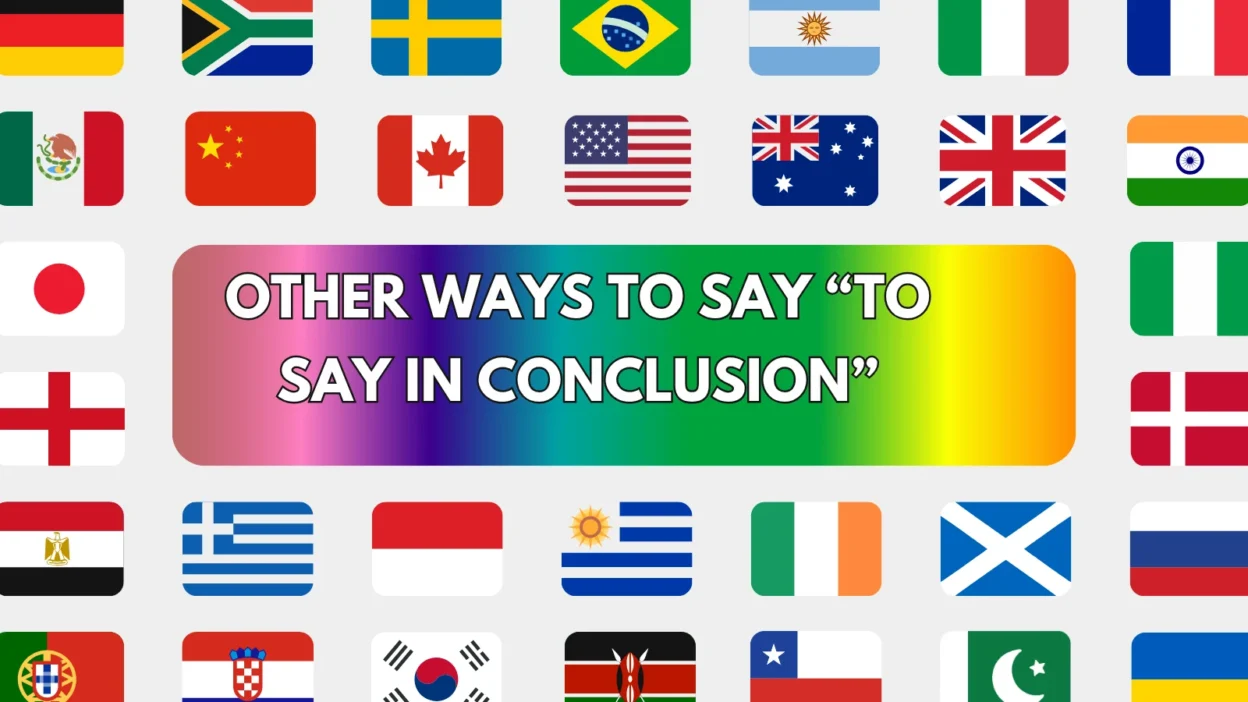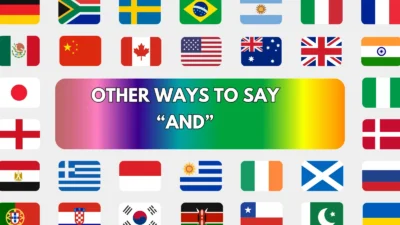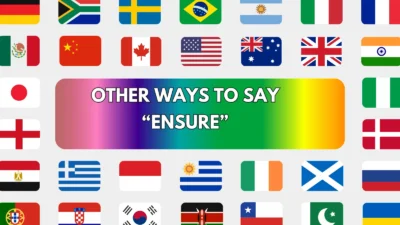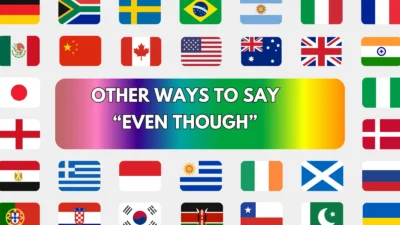When wrapping up a message, speech, or written piece, the phrase “to say in conclusion” helps signal the end of your thoughts. But repeating the same phrase can make your communication feel stale or robotic — especially in professional writing, presentations, or reports.
This article offers 25 polished alternatives to “to say in conclusion,” so you can close your arguments or thoughts with variety, elegance, and impact — tailored to different tones and settings.
1. In conclusion
Meaning:
Summarizes and finalizes what has been discussed.
Detailed Explanation:
This classic phrase is still highly effective, especially in formal writing or presentations. It signals the final section of a structured piece.
Scenario Example:
In conclusion, our findings support the proposed strategy for Q4.
Best Use:
Essays, presentations, business reports.
Tone:
Formal, traditional.
2. To sum up
Meaning:
Briefly gathers all main points together.
Detailed Explanation:
A casual and concise way to introduce a summary. Less formal than “in conclusion” but still professional.
Scenario Example:
To sum up, we must prioritize quality, consistency, and speed moving forward.
Best Use:
Team meetings, casual reports, emails.
Tone:
Clear, approachable.
3. In summary
Meaning:
Provides a short recap of the main ideas.
Detailed Explanation:
A neat and tidy way to begin a summary — ideal when you want to review key points.
Scenario Example:
In summary, our marketing efforts are working, but budget reallocation is needed.
Best Use:
Business writing, presentations.
Tone:
Professional, concise.
4. Overall
Meaning:
Gives a general overview of everything covered.
Detailed Explanation:
Used to express the main takeaway or final insight after considering all aspects.
Scenario Example:
Overall, the team’s progress has exceeded expectations.
Best Use:
Emails, analysis reports, discussions.
Tone:
Neutral, summarizing.
5. To wrap things up
Meaning:
Indicates you’re ending and summarizing your points.
Detailed Explanation:
A friendly and conversational alternative that still works in semi-formal contexts.
Scenario Example:
To wrap things up, we’ll send a follow-up with key action items.
Best Use:
Meetings, webinars, workshops.
Tone:
Informal, friendly.
6. In closing
Meaning:
Marks the end of a discussion or presentation.
Detailed Explanation:
A polished and respectful phrase often used to finish speeches or public addresses.
Scenario Example:
In closing, I want to thank everyone for their hard work and dedication.
Best Use:
Speeches, thank-you notes, professional conclusions.
Tone:
Formal, respectful.
7. Lastly
Meaning:
Introduces the final point or summary.
Detailed Explanation:
Simple and effective, this word signals your last idea or remark.
Scenario Example:
Lastly, let’s remember that communication is key to collaboration.
Best Use:
Structured lists, summaries, presentations.
Tone:
Direct, clear.
8. Finally
Meaning:
Introduces the final part of your statement.
Detailed Explanation:
Similar to “lastly” but often used when concluding a series of arguments or steps.
Scenario Example:
Finally, we recommend launching the campaign next week.
Best Use:
Essays, speeches, task breakdowns.
Tone:
Neutral, organized.
9. All things considered
Meaning:
Summarizes a balanced or overall judgment.
Detailed Explanation:
Best used when discussing pros and cons, or when making a thoughtful final judgment.
Scenario Example:
All things considered, outsourcing the task will be more efficient.
Best Use:
Analytical writing, discussions.
Tone:
Reflective, balanced.
10. To close
Meaning:
Signifies you’re ending the conversation or text.
Detailed Explanation:
Short and smooth, this phrase works especially well in spoken contexts or messages.
Scenario Example:
To close, let’s all commit to the action plan discussed.
Best Use:
Presentations, closing remarks.
Tone:
Professional, easygoing.
11. In brief
Meaning:
Introduces a quick summary of the main points.
Detailed Explanation:
Use this when you’re summing up in just a sentence or two.
Scenario Example:
In brief, we exceeded targets and stayed within budget.
Best Use:
Reports, emails, quick recaps.
Tone:
Concise, professional.
12. To summarize
Meaning:
Clarifies that you’re giving a recap of key ideas.
Detailed Explanation:
Formal and direct, ideal when presenting data or structured arguments.
Scenario Example:
To summarize, the initiative reduced costs by 15% and improved morale.
Best Use:
Reports, presentations.
Tone:
Clear, professional.
13. As a final note
Meaning:
Adds one last thought or reminder before ending.
Detailed Explanation:
This phrase adds a personal touch or final reflection.
Scenario Example:
As a final note, don’t forget to complete your evaluations by Friday.
Best Use:
Emails, closing reminders.
Tone:
Friendly, thoughtful.
14. To finalize
Meaning:
Signals the very end of your message or process.
Detailed Explanation:
Works well when discussing actions or decisions.
Scenario Example:
To finalize, we’ll schedule the rollout for July 1st.
Best Use:
Project planning, meeting wrap-ups.
Tone:
Firm, decisive.
15. Wrapping up
Meaning:
Indicates the discussion or report is ending.
Detailed Explanation:
Casual and conversational — perfect for relaxed team environments.
Scenario Example:
Wrapping up, let’s stick to the new roadmap and share updates weekly.
Best Use:
Team meetings, brainstorming.
Tone:
Casual, collaborative.
16. In essence
Meaning:
Highlights the core message or main idea.
Detailed Explanation:
Often used when distilling a complex idea into a simple summary.
Scenario Example:
In essence, our goal is to simplify the user journey.
Best Use:
Strategic summaries, writing.
Tone:
Intellectual, refined.
17. As a takeaway
Meaning:
Emphasizes the main message the audience should remember.
Detailed Explanation:
Focuses on what should stick in the reader or listener’s mind.
Scenario Example:
As a takeaway, always prioritize customer feedback.
Best Use:
Workshops, reports, presentations.
Tone:
Clear, memorable.
18. Looking back
Meaning:
Reflects on what was previously discussed.
Detailed Explanation:
Useful for reviews or debriefs that include past actions or decisions.
Scenario Example:
Looking back, it’s clear the change was necessary.
Best Use:
Project reviews, feedback sessions.
Tone:
Reflective, analytical.
19. To bring this to a close
Meaning:
States you’re ending the discussion or topic.
Detailed Explanation:
Polished and formal — a smooth way to wrap up public speaking or written points.
Scenario Example:
To bring this to a close, let’s focus on next steps.
Best Use:
Presentations, formal documents.
Tone:
Professional, composed.
20. As a conclusion
Meaning:
Similar to “in conclusion,” it introduces a summarizing thought.
Detailed Explanation:
This variation sounds a bit more academic or structured.
Scenario Example:
As a conclusion, investing in training leads to long-term savings.
Best Use:
Reports, academic writing.
Tone:
Formal, precise.
21. In total
Meaning:
Highlights the entire result or sum of all points made.
Detailed Explanation:
Often used when presenting data or outcomes collectively.
Scenario Example:
In total, we achieved a 30% increase in sales this quarter.
Best Use:
Financial reports, business analysis.
Tone:
Data-driven, concise.
22. In hindsight
Meaning:
Reviews decisions or actions with the benefit of reflection.
Detailed Explanation:
Best when concluding lessons learned or revisiting outcomes.
Scenario Example:
In hindsight, the delay allowed us to improve the final product.
Best Use:
Post-project reviews, case studies.
Tone:
Reflective, analytical.
23. As the final thought
Meaning:
Leaves the audience with a lasting idea.
Detailed Explanation:
Perfect for ending with a message that resonates emotionally or intellectually.
Scenario Example:
As the final thought, remember: consistency builds credibility.
Best Use:
Speeches, conclusion slides.
Tone:
Thoughtful, impactful.
24. When all is said and done
Meaning:
Summarizes everything after thorough discussion.
Detailed Explanation:
Colloquial and expressive, great for emphasis or conclusions with a personal tone.
Scenario Example:
When all is said and done, the team’s resilience is what truly mattered.
Best Use:
Storytelling, inspirational talks.
Tone:
Reflective, personal.
25. And that’s a wrap
Meaning:
A fun and modern way to say “we’re done.”
Detailed Explanation:
Casual and informal — great for ending meetings or informal communication.
Scenario Example:
And that’s a wrap for today’s training session!
Best Use:
Team meetings, friendly settings.
Tone:
Playful, upbeat.
Conclusion
Using the same phrase like “to say in conclusion” can feel repetitive and flat, especially in professional communication. With these 25 fresh and versatile alternatives, you can express your final thoughts with clarity, confidence, and creativity — tailored to any tone, audience, or setting.




